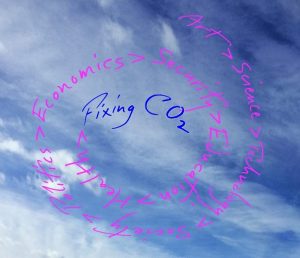There’s no end in sight for abating global greenhouse emissions. We need fresh insights into how we can rapidly and realistically fix the problem once and for all, using viable methods for stabilizing the amount of CO2 in the atmosphere. This should be our primary global goal and task, which we’ve already agreed to act on to achieve the 2015 Paris Agreement http://mission-innovation.net/.
Now is the time for a massive influx of patient and flexible government funding and private investment from visionary countries, to create new tools that can power the world without the accompanying production of CO2.
Two basic strategies exist in principle for putting a safe cap on atmospheric CO2 in the next 20-30 years. One uses CO2 capture and storage, the other utilizes the captured CO2 for making value-added chemicals and fuels.

Graphic illustrating “Fixing CO2”showing the sphere or circle of interconnected influences and influencers that need to help realize this global challenge. Courtesy of Todd Siler and Geoffrey Ozin, www.artnanoinnovations.com.
In the wake of the Paris conference a great deal of hope has been placed on the large number of CO2 capture and storage, and biomass projects underway. Unfortunately, their economic viability and ability to meaningfully decrease our greenhouse gas emissions and solve our energy issues in the foreseeable future are in serious doubt.
It is touted that captured CO2, rather than being stored can be used as a carbon-negative solution for the enhanced recovery of oil. While technically feasible, it is not a permanent solution as it does not account for CO2 leakage and the liberation of CO2 by dissolution of carbonates. Moreover, it is enormously expensive, not to mention the fact that it’s very difficult to justify using CO2 to get more fossil fuels out of the ground. I mean, the public raises its eyebrow and grimaces: Is this really a climate-friendly solution?
Advocates of biomass and bioenergy technologies also claim that biological CO2 fixation is key to sustainability being carbon-negative. If the US was to replace gasoline with biodiesel they would need seven times the area of the USA to plant corn. Yet, do the energy and economic flows account for the massive loss of food productive land and justify the overall gain in CO2 from growing, harvesting, processing, storing and transporting the biological feedstock and products?
Sources of renewable solar and wind energy are expanding at an ever increasing pace around the world. The question is how long will we have to live with the adverse effects of climate change caused by the continuous rise of anthropogenic CO2 from our continued reliance on the use of fossil energy?
In the urgent search for the innovation solution to fix CO2, there does however appear to be agreement that the economic viability of CO2 capture and storage can be improved by working hand-in-hand with utilization of the CO2 for producing value-added chemicals and fuels. This strategy is under development in a range of established and emerging industries around the world that productively fix CO2 in the form of fertilizers, cement, chemicals and polymers, and aviation and diesel fuels, at the mega ton scale. If we already have commercialized technologies that utilize CO2 at the mega ton scale what’s stopping us from expanding the capacity of these industries to a globally-significant, climate-friendly scale?
It is important to keep in mind that any utilization process based upon hydrogenation of CO2 will necessitate a large-scale source of inexpensive H2 other than fossil-based steam reforming of methane, coal gasification or partial oxidation of oil. Ultimately, this will likely have to come from H2O electrolysis powered by renewable forms of electricity or photoelectrolysis using sunlight.
With a world “drowning” in CO2 and H2O, this all seems like a no-brainer! Clearly, there is an urgent need for a large and rapid injection of public and private funds into research and development aimed at ironing out the scientific and technological challenges of bringing CO2 utilization industries on stream. Isn’t the key to economical, sociological and political success, to prove that it is possible to scale CO2 utilization processes to proportions that can make a difference to climate change?
Success-breeds-success. Demonstration of technologically and economically sensible ways of fixing CO2 to value-added chemicals and fuels, in a reasonable time frame, will breed confidence in further private and public investment that will facilitate globally significant quantities of CO2 to be converted from a liability to an asset.
Transformative ideas are emerging from academic, industry and government research institutions aimed at discovering molecules, materials and processes that can transition our energy future to a near zero emissions world. The question is how do we get the most innovative and promising research ideas from the lab-to-market to protect us from the adverse effects of climate change?
It is exciting that Bill Gates and an impressive list of billionaire private investors, with collective holdings of $350B, have founded “The Breakthrough Energy Coalition”, http://www.breakthroughenergycoalition.com/en/index.html. Their mandate is to work with a growing list of visionary countries who collective agree that a solution to climate change will require faster action than the energy sector has ever mustered before. They have committed to double government spending on basic and applied energy research in the next five years to fix climate change.
This is because transitions in energy generation historically take more than fifty years to implement and he warned “the climate threat is too serious to allow technology to evolve at the usual slow pace”. It is exciting that on their list of “cool” energy innovations includes, solar-chemical technology, which converts the sun’s energy into hydrocarbons that can be stored and used as fuel, https://www.washingtonpost.com/news/energy-environment/wp/2015/11/30/bill-gates-on-climate-change-we-need-to-move-faster/.
The return on investment to fund a “fast-track” global energy transition that treats CO2 as a chemical resource rather than a waste product is beyond profit making. It’s a moral imperative. Implementing this energy transition will advance the common good by improving the quality of life for all of humankind.
We all love CO2 – let’s do it, let’s fix CO2 fixation!

















